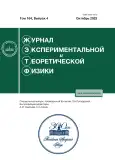Role of Vacancies in the Yao–Lee Model
- 作者: Polyakov V.A1, Perkins N.B2
-
隶属关系:
- Moscow Institute of Physics and Technology (National Research University)
- School of Physics and Astronomy, University of Minnesota
- 期: 卷 164, 编号 4 (2023)
- 页面: 615-625
- 栏目: Articles
- URL: https://journals.rcsi.science/0044-4510/article/view/247337
- DOI: https://doi.org/10.31857/S0044451023100140
- EDN: https://elibrary.ru/XLNIRM
- ID: 247337
如何引用文章
全文:
详细
We consider the effect of vacancies on the low-energy excitation spectrum of a quantum spin liquid realized in the exactly solvable Yao–Lee model [H. Yao and D.-H. Lee, Phys. Rev. Lett. 107, 087205 (2011)]. Physically, vacancies can appear for different reasons (e.g., because of zero magnetic moments on the lattice, or the presence of nonmagnetic impurities, or a random reduction of local bonds of magnetic moments with the remaining lattice). It is shown numerically that the finite density of random vacancies in this model leads to the accumulation of states near zero energy, which can be detected from the change of the behavior of heat capacity at low temperatures. Moreover, it is shown that the low-energy modes are localized more strongly than remaining eigenmodes. This effect is illustrated using the inverse participation ratio (IPR). In the case of time reversal symmetry breaking (e.g., due to the presence of a magnetic field), a gap is opened in the fermion spectrum of the model, and vacancy-induced localized states appear. The energies of these states depend on the structure of the interactions responsible for the time inversion symmetry breaking.
作者简介
V. Polyakov
Moscow Institute of Physics and Technology (National Research University)
Email: poliakov.va@phystech.edu
141701, Dolgoprudny, Moscow oblast, Russia
N. Perkins
School of Physics and Astronomy, University of Minnesota
编辑信件的主要联系方式.
Email: nperkins@umn.edu
55455, Minneapolis, MN, USA
参考
- H. Yao and D.-H. Lee, Phys. Rev. Lett. 107, 087205 (2011).
- W. Witczak-Krempa, G. Chen, Y. B. Kim, and L. Balents, Ann. Rev. Cond. Matt. Phys. 5, 57 (2014).
- C. L. Kane and E. J. Mele, Phys. Rev. Lett. 95, 146802 (2005).
- B. A. Bernevig and S.-C. Zhang, Phys. Rev. Lett. 96, 106802 (2006).
- R. Moessner and J. E. Moore, Topological Phases of Matter (Cambridge University Press, 2021).
- P. W. Anderson, Mater. Res. Bull. 8, 153 (1973).
- L. Balents, Nature 464, 199 (2010).
- L. Savary and L. Balents, Rep. Prog. Phys. 80, 016502 (2017).
- M. R. Norman, Rev. Mod. Phys. 88, 041002 (2016).
- J. Knolle and R. Moessner, Annu. Rev. Condens. Matter Phys. 10, 451 (2019).
- C. Broholm, R. J. Cava, S. A. Kivelson, D. G. Nocera, M. R. Norman, and T. Senthil, Science 367 (2020).
- H. Takagi, T. Takayama, G. Jackeli, G. Khaliullin, and S. E. Nagler, Nat. Rev. Phys. 1, 264 (2019).
- A. Kitaev, Annals of Physics 321, 2 (2006).
- H. Yao, S.-C. Zhang, and S. A. Kivelson, Phys. Rev. Lett. 102, 217202 (2009)
- F. Wang and A. Vishwanath, Phys. Rev. B 80, 064413 (2009).
- C. Wu, D. Arovas, and H.-H. Hung, Phys. Rev. B 79, 134427 (2009).
- R. Nakai, S. Ryu, and A. Furusaki, Phys. Rev. B 85, 155119 (2012).
- V. S. de Carvalho, H. Freire, E. Miranda, and R. G. Pereira, Phys. Rev. B 98, 155105 (2018).
- G. Jackeli and G. Khaliullin, Phys. Rev. Lett. 102, 017205 (2009).
- J. Chaloupka, G. Jackeli, and G. Khaliullin, Phys. Rev. Lett. 105, 027204 (2010).
- A. J. Willans, J. T. Chalker, and R. Moessner, Phys. Rev. Lett. 104, 237203 (2010).
- A. J. Willans, J. T. Chalker, and R. Moessner, Phys. Rev. B 84, 115146 (2011).
- J. Knolle, R. Moessner, and N. B. Perkins, Phys. Rev. Lett. 122, 047202 (2019).
- J. Nasu and Y. Motome, Phys. Rev. B 102, 054437 (2020).
- W.-H. Kao, J. Knolle, G. B. Halasz, R. Moessner, and N. B. Perkins, Phys. Rev. X 11, 011034 (2021).
- W.-H. Kao and N. B. Perkins, Ann. Phys. 435, 168506 (2021).
- W.-H. Kao and N. B. Perkins, Phys. Rev. B 106, L100402 (2022).
- V. Dantas and E. C. Andrade, Phys. Rev. Lett. 129, 037204 (2022).
- P. W. Anderson, Phys. Rev. 109, 1492 (1958).
- I. M. Lifshitz, Soviet Physics Uspekhi 7, 549 (1965).
- A. Y. Kitaev, Physics-Uspekhi 44, 131 (2001).
- C. Nayak, S. H. Simon, A. Stern, M. Freedman, and S. Das Sarma, Rev. Mod. Phys. 80, 1083 (2008).
- J. D. Sau, S. Tewari, R. M. Lutchyn, T. D. Stanescu, and S. Das Sarma, Phys. Rev. B 82, 214509 (2010).
- R. R. Biswas, Phys. Rev. Lett. 111, 136401 (2013).
- K. Damle, Phys. Rev. B 105, 235118 (2022).
- D. A. Ivanov, Phys. Rev. Lett. 86, 268 (2001).
- S. Tewari, S. Das Sarma, and D.-H. Lee, Phys. Rev. Lett. 99, 037001 (2007).
- V. Gurarie and L. Radzihovsky, Phys. Rev. B 75, 212509 (2007).
- R. Roy, Phys. Rev. Lett. 105, 186401 (2010).
- C. Xu, J. Feng, M. Kawamura, Y. Yamaji, Y. Nahas, S. Prokhorenko, Y. Qi, H. Xiang, and L. Bellaiche, Phys. Rev. Lett. 124, 087205 (2020).
- E. H. Lieb, Phys. Rev. Lett. 73, 2158 (1994).
补充文件









